Catharanthus roseus is a beautiful flowering perennial herb which is always in bloom as ornamental plant. It is known as Madagascar periwinkle. This plant characterized as terpenoids indole alkaloid producing plant cultivated in warm region. Besides alkaloid it is rich in phenolic compounds, organic acids and amino acid of pharmacological significance in its different parts. Traditionally, this herbal plant is boon to provide protective action for many deadly health problems being faced by humans by their direct or indirect usage in skin disease, high blood pressure, rheumatism, menstrual disorders, indigestion etc. But nowadays, transition to modern and formulated treatment has been increased. Alkaloid vincristine, vinblastine, vinflunine, vinorelbine and vindesine are clinically approved for treatment regimen. Its pharmacological actions are ranging from antimicrobial to antineoplastic which are discussed to understand the health promoting properties. Catharanthus roseus is a nontoxic traditional medicinal plant but its semifinished and finished products are prone to certain kind of toxic effects. Major anticancer drugs isolated from C. Roseus are Oncovin and Velban marketed world widely in millions of tons. This article provides evidence for clinical effectiveness and toxicity of approved phytoconstituents which is relevant for safety evaluation of various folksier and pharmacological activities.
Alkaloid, Chemical constituents, Pharmacological action, Periwinkle, Traditional plant, Toxic effect
Catharanthus roseus is an evergreen, erect, long-lived flowering plant. Catharanthus L.G. Don is formed from the Latin term Kantharos (pure) and Anthos (flower), which indicate to the blossom's beauty whereas roseus denotes red, rose, or rosy. Catharanthus roseus L. (G.) Don is a dicotyledonous angiosperm that placed into the dog-bane family, Apocynaceae. There are eight known species of genus Catharanthus. C. coriaceus Markgr., C. lanceus (Bojer ex A.DC.) Pichon, C. longifolius (Pichon) Pichon, C. ovalis Markgr., C. pusillus (Murray) G.Don, C. roseus (L.) G.Don,C. scitulus (Pichon) Pichon, C. trichophyllus (Bak) Pichon. Out of eight, seven are native to Madagascar. C. pusillus is indigenous to India and Sri Lanka while one is native to China [1]. Periwinkle has been used as a hemorrhagic, diuretic and wound healer in European folk medicine since 50 B.C. In the 18th century, it was set in motion to various countries of the world. It is supposed that it was introduced in India by Portuguese mercenaries in Goa in the mid-eighteenth century. C. roseus is a native to the Indian Ocean Island of Madagascar. This plant is cultivated in tropical, subtropical and temperate biogeographic range around the world, including Mauritius, Philippines, Bahamas, Cuba and the southern United States whereas Malaysia, Jamaica, Australia, Africa, India, and Southern Europe to serve commercial demand in pharmaceutical industry as well as indigenous systems of medicine [2]. Poor, well-drained soil at pH 5.5–6.5 and salt up to 2000?ppm can withstand. It shows excellent tolerance toward heat and drought also full sun or partial shades are optimum for its growth. It is sensitive to cool spring and over watering. It is a self-propagating plant from seeds and grows to about 2 feet in length, sprawl up to 2.1 feet, 1 foot spread, long branched, and developed a woody base with lustrous, dark green leaves. Western Australia, the Australian Capital Territory, and areas of Queensland (south-Eastern) considered it as noxious weed. Due to habitat disturbance by burn agriculture and slash, C. roseus becomes an endangered species. "Rosea" (pink flowers) and "Alba" (white flowers) are two popular kinds of C. roseus named after their flower color. As a result of ongoing study, there is inconsistency in plant taxonomic nomenclature in the literature. Taxonomical classification is shown in Table 1 [3]. C. roseous is rich in phenolic content, organic acids, steroids, flavonoids, glucoside, tannins, terpenoids and volatile content. C. roseus (L.) G. Don is their vincristine and vinblastine which are major significant alkaloids. In the 1950's, western researcher came to know toxic alkaloids in its tissue. The Catharanthus alkaloids are a group of approximately 129 terpenoid indole alkaloids (TIAs) that are utilized as medications, agrochemicals, flavor and fragrance, components, food additives, pesticides. Catharanthus roseus produces the anticancer bisindole alkaloids vinblastine and vincristine, which are derived from the union of the monomeric terpenoid indole alkaloids catharanthine and vindoline [4]. Main Chemical constituent’s vincristine and Vinblastine are derived from the plant’s leaves and these are effective in treating diabetes, platelets related disease, and both malignant and non-malignant cancer. Ajmalicine, reserpine and serpentine are found in the roots beneficial as antihypertensive. The two most significant anticancer medications derived from C. roseus, Oncovin and Velban, are sold for a combined US$100 million. Besides its usefulness, vinblastine and vincristine is also prone to toxicity as they are susceptible to poisoning and various deadly side effects in form of their finished product. For centuries, Indian medical systems including Ayurveda, Unani, Siddha, and traditional Chinese medicine have utilized the numerous plant parts of C. roseus. The herb has historically been used to alleviate sadness, wasp stings, and muscle pain. It is utilized to treat gum, nose, sore throat, and mouth ulcers. Internally, it provokes defense system which acts as, anti-hypertension, antimicrobial, anti-diabetic and anticancer. This review aims to accurately emphasize the clinical and folksier influence of this plant against many diseases. It includes phytoconstituents, clinical pharmacology, ethnopharmacological activities, and economic importance in order to aid scientists and learners in appreciating the plant's essential values.
VERNACULAR NAMES OF
CATHARANTHUS ROSEUS
Common name
(Periwinkle,Bright eyes,Graveyard-plant,Vinca), English (Vinca rosea, old-maid, Cape periwinkle, Lochnera rosea, Ammocallis rosea) Hindi (Sadabahar), Kannada (Kempukesi, Kanigalu), Oriya (Visayan), Punjabi (Rattanjot), Sanskrit
(Nityakalyani), Tamil (Sudukattumallikai), Telugu (Billaganneru), Africa (Kanniedood), Bangladesh (Nayantara), Brazil (Boa-noite, Congorca), Chinese (Chang Chun Hua), Cook Islands (Tiare-tupapaku-kimo, Dominica (Cacapoule), Dutch (Roze maagdenpalm), Jamaica (Periwinkle), European (Vinca branca), French Guiana (Pervenchede de Madagascar), German (Zimmerimmergrun), Guatemala (Chatilla), Guyana (Periwinkle), Indonesian (Tapakdara, kembang sari cina), Japan (Nichinich-so, Nichinichi-so), Kenya (Maua), Madagascar (Madagascan periwinkle), Mexico (Ninfa), Pakistan (Sada-bahar), Philippines (Atay-biya, Chichirica, Kantotan, Periwinkle, Tsitsirika), Persian (Gul-e-farang), Peru
(Chavelita), Portuguese (Boa-noite, Boa-tarde, Lavadeira, Pervinca-rosa, Vinca-de-gato, Vincade-Madagascar, Vina-rosea), Rodrigues Islands (Saponaria), Spanish (Vinca rosada), Sri
Lanka (Mini-mal, Patti-poo), Swedish (Rosenskona), man’s fancy, Consumption bush, Old maid,
Table 1: Botanical classification.
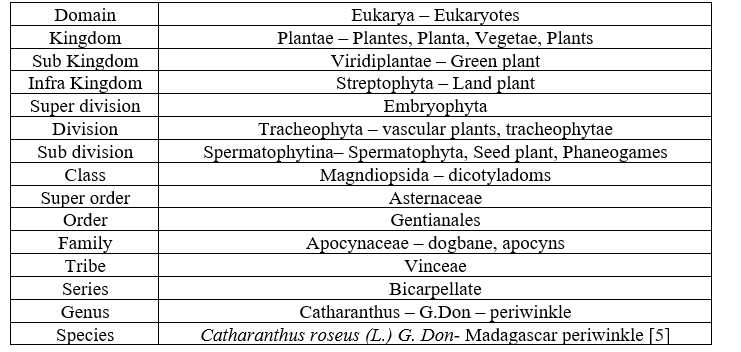
Thailand (Phaengphoifarang, Phang-puaifarang), USA (Periwinkle), Venda (Liluvha), Vietnam (Dua can) and West Indies (Brown
BOTANICAL INFORMATION
Catharanthus roseus plant is usually erect, 30-100 cm high, with a woody base, sometimes sprawling.When tiny, stems have pubescence and are tubular (terete), striated or somewhat winged, green or dark crimson in hue. Elliptical in shape, long and wide about 2.6–9.4 centimeters, 1–2.5 centimeter respectively, hairless, bright green in colour with yellowish midrib also has short, opposite-paired about1– 1.8 centimeter petiole. On the leaf axils, flowers are produced or couples form, and their stalks are quite short. Sepals are thin, shaggy, and usually 5 to 6 mm in length. The corolla tube is long, green, and often at least 2.2 cm long in contrast to the short calyx tube. It is pubescent within the neck, with thick hair rings below the stamen. It features 5 corolla lobes that range in length from 1.0 to 2.8 cm and are pink to white or pinkish purple in color, as well as the corolla tube's tip is connected to five anthers on the interior and the ovary is long with pentagonal stigma. Fruits feature two follicles that are 2.04.7 cm long and contain multiple little black seeds [6]. Periwinkle, Pinkflower, Ram goat rose, Red rose, Sailor’s flower, White tulip) [1, 5].
QUANTITATIVE STANDARDS
Foreign organic content a maximum of
2.5%, no more than 14.6% of ash, no more than 1.0% of acid insoluble ash, extract solubility in alcohol is 12.0% minimum, extract that is water soluble is at least 40.0% [7].
CHEMICAL COMPOSITION
Catharanthus roseus accommodate various phytocompounds of pharmacological significance. Alkaloids are found in abundant beside these, glycosides, tannins, proteins, coumarin, saponin, carbohydrates, quinine, triterpenoids, volatile, and phenolic chemicals are prominent in Catharanthus roseus [8]. Other secondary metabolites from C. roseus have also been identified, such as steroid (catasteron, brassinolides), flavonoids, anthocyanins, and monoterpenoid glucosides (loganin, secologanin, sweroside, deoxyloganin, and dehydrologanin) [9]. All plant's parts, including the leaf, shoot, root, petals and seeds have abundant bioactive substances. Flowers and leaves were analyzed in six different solvents for their phytochemical constituents, including carbohydrates, steroids, alkaloids, tannins, phenols, flavonoids, quinones, glycosides, saponins and other phytochemicals including Amino acids, Anthocyanin, Anthraquinones, Carotenoids, Coumarin, Diterpinoid, Emodins, Fatty acids, Phytosterol and Proteins [10]. About 20% of plant species are estimated to have alkaloids. Alkaloids have a vital role in human life as medicines or a luxury, which has piqued the curiosity of many researchers across a variety of scientific disciplines. There are around 400 alkaloids in this plant, of which 130 are monoterpenoid indole alkaloids (MIAs), including most significant available two cytotoxic dimeric alkaloids, vincristine and vinblastine. Few more alkaloids that have been discovered are deoxyvinblastine, leurocristine, leurosine, leurosidine, pleurosin, roseadine, rosicine, vinacardine, vincolinine and vindolicine [9]. Ajmalicine, Ajmaline, Leurosine, Catharanthine, Serpentine, Lochnerine, Vindoline, Vindesine and Yohimbine are some of the alkaloids found in every part of the plant given in Table 1 [11,12]. Anthocyanin pigment named rosindin found in the flower. In comparison to stems (0.46%) and leaves (0.7-2.4%), roots had higher active alkaloidal compounds (0.37-1.15). Additionally, C. Roseus discovered that phenolic compounds, in several form tannins, simple phenolics, phenolic acids, lignins, flavonoids and isoflavonoids, accumulate after biotic and abiotic stress are shown in Table 2. [13,14]. Catharanthus roseus also rich in organic acid and amino acid which are found in leaf, stem, seed, and petals [15]. Quantitative estimation of various constituents is done by thinlayer chromatography, high-performance thinlayer chromatography, gas chromatography, and highperformance liquid chromatography as well as structure of these constituents are elucidate by UV, IR, NMR, MS.
Table 2: Alkaloids and Phenolic compounds in different part of Catharanthus roseus.
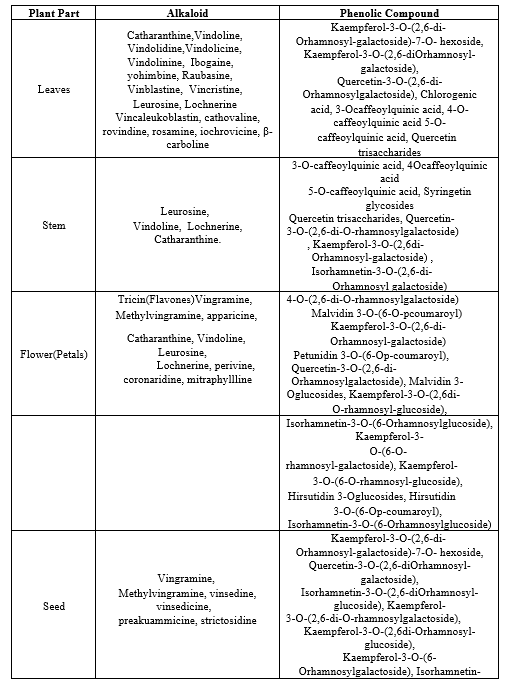
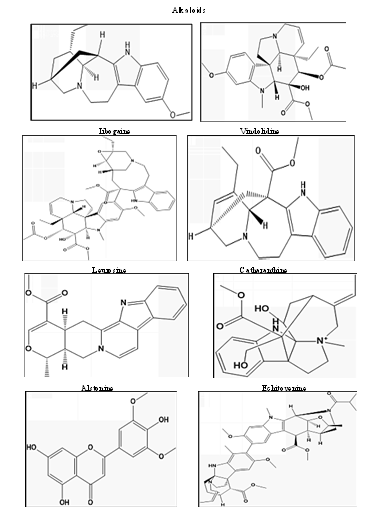
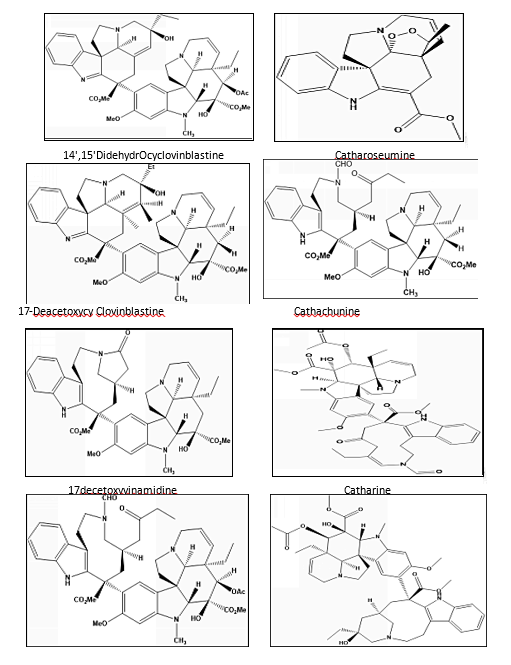
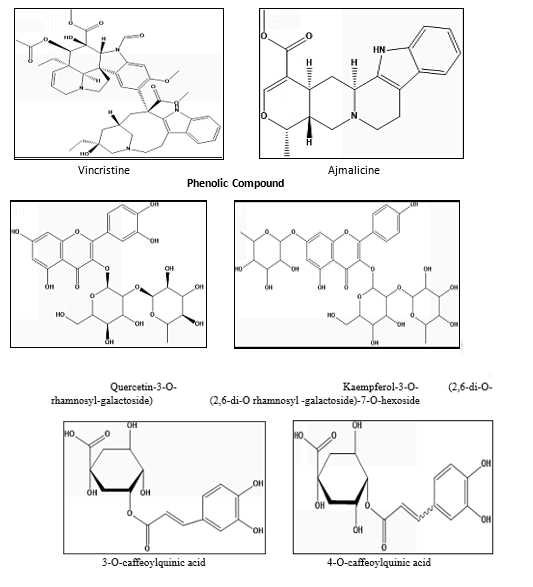
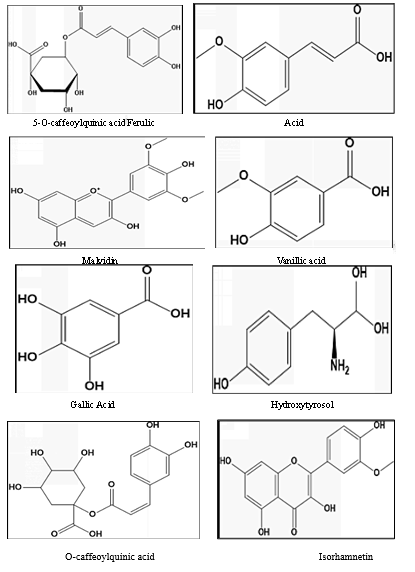
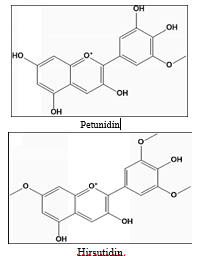
ETHNO-MEDICINAL USES
Ayurveda as well as traditional medicinal system has been widely used this plant. In this manner, there is a way to treat burns by using crushed Catharanthus Roseus leaves on burns. The effect is to cool the skin, relieve pain, and prevent super infection. In folklore, Catharanthus Roseus herb has been used to treat rheumatism, skin-lifting, treat less and painful urination, menstrual disorders, high blood pressure, sweating, blood thinning and poor digestion problems in many countries (Fig. 1) [16].
Australia:
For menorrhagia, rheumatism and diabetes, extracting dry leaves in hot water is administered, while a root bark extract is given internally as a febrifuge.
America:
Gargle of C. roseus to treat laryngitis, sore throats, chest pain, and sore throats. Bahamas: Flour decoction is used to treat asthma, flatulence and tuberculosis.
Brazil:
The leaves of the plant were used to cure scurvy, bleeding, also possess wound healing and cleaning function and as a mouthwash for toothaches.
China and North Vietnam: As a menstrual regulator, the aerial portions’ hot water extract is taken.
Cook-Island:
Dried leaf decoction administered to treat diabetes, cancer and hypertension. Cuba and Jamaica: In infants, flowers extract as a preparation for eye wash.
Dominica:
To help pregnant Lady ingesting warm water extract of the leaves to overcome primary lethargy during childbirth.
England, Europe, Jamaica, Kenya, Thailand, and West Indies:
The hot water boiled leaves and whole plant extracts are used to treat diabetes when administered.
France and South Vietnam:
Warm water extract of whole plant have anti-galactagogue properties. French Guina: Hot water whole plant extract is administered as cholagogue. Hawai:
To stop bleeding, a boiled plant extract is used.
India: To cure skin disorders like eczema, dermatitis, and acne, Ayurvedic doctors in India employed the fresh juice from C. rosea blossoms. To cure diseases such as Hodgkin's disease, Wilms tumor, leukemia, neuroblastoma, rhabdomyosarcoma, malignant lymphomas people take an ingested warm water extract of the whole dried plant and root extract for menorrhagia. Bee and wasp stings are treated with the leaf juice. To cure diabetes, the dried whole plant powder with cow's milk is ingested by tamilians of Kancheepuram district.
Madagascar:
To induce vomiting, leaves are utilized while roots act as toothache cure, purgative, homeostatic, vermifuge and depurative.
Malaysia:
Diabetes, insomnia, hypertension and cancer are all treated with this plant.
Mauritius:
To get relief from indigestion and dyspepsia, juice of its leaves is beneficial
Mexico:
For stomach problems, a whole plant infusion is administered.
Pakistan:
Dried ovule’s warm water extract is utilized for the treatment of diabetes as oral preparation.
Peru:
Human used dried whole plant extract to treat cancer, leishmaniasis and heart disease. Philippines:
Pregnant women take root decoction to induce abortion in general; people also use it in dysentery and intestinal parasitism while to treat diabetes and stomach cramps, people taken leaf decoction. Menorrhagia is treated with an infusion Figure 1:Ethnopharmacological Uses made from the leaves.
South Africa:
Dried leaves extract is used to treat for rheumatism, diabetes and menorrhagia. C. roseus dried root decoction is used against urogenital infections and gonorrhoea.
Taiwan: Decoction of the dried whole plant cures diabetes mellitus and liver disease.
USA:
The leaves extract is smoked as a euphoriant.
Venda:
For venereal disease, root extract is very helping in oral dosing.
Vietnam:
In Vietnamese traditional medicine, dried aerial part’s extract is listed in the Vietnamese pharmacopoeia and used as a drug. Zimbabwe: This plant used for stomach ache in the Mutirikwi region.
CLINICAL PHARMACOLOGY
Catharanthus Roseus can be used as medicine with the whole Catharanthus Roseus in various forms as decoction, dried powder, and tablets and in liquid form. The dosage is typically 8–20g/day. On the market, Catharanthus Roseus extract is usually sold as vincaleucoblastin or vinblastin sulfate salt, which was introduced in 1960 and dosage injected of about 0.10–0.15 mg/kg body weight. The drug is used to treat Hodgkin's cancer, testicular cancer, Kaposi's sarcoma and has a great effect on cell inhibition or cell division. Vinblasti
Figure 1:Ethnopharmacological Uses made from the leaves.
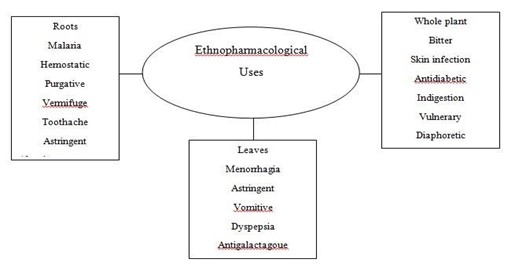
South Africa:
Dried leaves extract is used to treat for rheumatism, diabetes and menorrhagia. C. roseus dried root decoction is used against urogenital infections and gonorrhoea.
Taiwan:
Decoction of the dried whole plant cures diabetes mellitus and liver disease.
USA:
The leaves extract is smoked as a euphoriant.
Venda:
For venereal disease, root extract is very helping in oral dosing.
Vietnam:
In Vietnamese traditional medicine, dried aerial part’s extract is listed in the Vietnamese pharmacopoeia and used as a drug. Zimbabwe: This plant used for stomach ache in the Mutirikwi region.
CLINICAL PHARMACOLOGY
Catharanthus Roseus can be used as medicine with the whole Catharanthus Roseus in various forms as decoction, dried powder, and tablets and in liquid form. The dosage is typically 8–20g/day. On the market, Catharanthus Roseus extract is usually sold as vincaleucoblastin or vinblastin sulfate salt, which was introduced in 1960 and dosage injected of about 0.10–0.15 mg/kg body weight. The drug is used to treat Hodgkin's cancer, testicular cancer, Kaposi's sarcoma and has a great effect on cell inhibition or cell division. Vinblastin demonstrated significantly increased antitumor efficacy against vinblastin resistant cells when it was administered in the form of multilamellar liposomes. Multidrug resistance can be overcome with the use of this tactic. In sealed ampoules kept in a dark, inert environment at room temperature, solid vinblastin can be safely stored. Research on animals has revealed that they are embryo-toxic, mutagenic, and carcinogenic as well as they also inhibit the nervous system, making them dangerous to the developing foetus. Other hazards that are also present include extravasation injury, gastrointestinal toxicity, significant vesicant activity, and bone marrow suppression (which is dose-limiting). Prescribing this drug to pregnant and lactate women and one with bacterial infection is not recommended by researchers. Another ingredient in this medicinal plant is leurocristine (or vincristine) in the form of sulfate salts, was introduced in 1963 administered at 0.03 to 0.11 mg/kg dose. It is mitotic inhibitor, used in non-Hodgkin’s lymphoma, blood diseases, acute lymphoblastic leukemia and nephroblastoma. They have some side effects include peripheral neuropathy, hyponatremia, constipation, lung spam and carcinogenic in some patients [17]. According to studies, the half-lives of vinblastin were 4 minutes, 1.6 hours, whereas vincristine had halflives of 4 minutes and 2.3 hours. Despite having a three to four times longer elimination phase than vinblastine, vincristine is slowly eliminated from neuronal sensitive tissue during clinical adjustments but is not the case with vinblastine. Approx. 10% of the prescribed dosage of these two is excreted through urine without any alterations. Low dose is recommended in liver disease patients [18]. Many adverse effects, including a little headache, hair loss, pale mouth, hyponatremia, stomach rumbling, myelosuppression, alopecia, abdominal cramps, constipation, and nausea/vomiting are common in the first two weeks, much like with other anticancer medications. Aside from that, there are additional effect like paralytic ileus, motor weakness, mouth ulcers, azoospermia, hepatocellular damage, kidney damage, parasthesias, urinary retention, amenorrhea, orthostatic hypotension, hypertension, pulmonary fibrosis, leukopenia, neuromyopathy, thrombopenia, depression, psychoses, peripheral neuritis, and convulsions. To lessen these adverse effects, the dosage and dosing frequency must be carefully adjusted [19-21]. The medication maybe regarded as safe when used according to dosage instructions. Vincristine has an LD50 of 5.2 mg/kg i.p and vinblastine has an LD50 of 17 mg/kg i.v in mice. Dosage 10 to 20 ml of expressed juice or 10 g of paste.
ECONOMIC MARKET OF C. ROSEUS
Bisindole alkaloids such as vincristine, vinblastin, vinorelbine and vindesine have been gain clinical approval from the US Food and Drug Administration as a chemotherapeutic purpose, other pharmacological and pharmaceutical uses. These compounds are more costly and in high price around the world. Due to their very low concentrations (about 0.0005% of dry weight) in the aerial portion of the plant, these chemicals are expensive. For example, a half-ton of C. roseus dried leaves are required to obtain 1000 mg of vinblastine, while 530 kg dry leaves are required to create 1000g of vincristine [22]. These have an annual market value of about 1,000,000– 3,500,000 dollar per kilogram. Vincristine sulfatebased medications (Oncovin and Vincasar PFS) are used to treat childhood leukemia and cost 15 dollar/mg or 15 million dollar/kg. While vinblastine sulphate-based medications (Velbane and Velsar) cost $2/mg or 2 million dollar/kg or 5 to 10 kg of vincristine and vinblastine. Worth a combined 25–50 million dollar, were consumed on global market in 1990. In 1991 3 to 5 tonnes of ajmalicine was utilized in the international market with a total market value of 4.5-7.5 million US dollars. The global market was thought to be worth 150–300 million in US dollars in 2005 [23].
THERAPEUTIC ACTIVITY
Catharanthus roseus is an antibacterial, antidiabetic, antioxidant, antidiarrheal, anthelmintic, anti-sterility and antifeedant medicinal plant. The alkaloids, main plant's elements, associated with different medicinal properties and were observed to be responsible for the plant's pharmacology.
Anti-Microbial Activity
According to Sheerazahmadwagay et al., 2013 [24] investigation, Catharanthus roseus crude ethanolic extract exhibited the highest antibacteriaactivity against E. coli, P. aeruginosa, Klebseilla pneumonia, Staphylococcus aureus, whereas Soxhlet methanolic extract exhibited the highest highest sensitivity against Staphylococcus aureus followed by Escherichia co/r, Klebsiella pneumoniae and Streptococcus pyrogens and Pseudomonas aeruginosa. Crude ethanolic extract was discovered to be the most effective extract among all. Moreover, it has been demonstrated that leaf extracts are more effective than flower, stem, and root extracts and can be utilized as a preventative agent. This is because the extract contains alkaloid and flavonoid components, which have strong antibacterial properties. Extract of this plant beneficial against herpes simplex virus and provide antiviral activity [25]. Trypanosoma cruzi, the parasite that causes trypanosomiasis in humans, was resistant to C. rosea's antiparasitic effects [26, 27]. Chloroform extract from C. roseus exhibits the highest antibacterial activity against Bacillus subtillis and then Micrococcus luteus, Staphylococcus aureus, with zones of inhibition of 17, 18, and 18mm, respectively, out of the methanol, chloroform, hexane, water, and ethyl acetate extract. At doses of 250µg, chloroform extract inhibits every tested organism. By using the disc agar-diffusion technique, the antibacterial activity was assessed in relation to E. coli. The largest inhibitory zone was seen in the ethyl acetate fraction compared to hexane or methanol [28].
Antifungal Activity
Aspergillus niger, Fusarium moniliforme, Aspergillus fumigatus and Candida albicans, and may all be effectively eradicated by Catharanthus roseus' antifungal properties. The paper disc diffusion technique was employed to evaluate Catharanthus roseus' antifungal efficacy. This experiment used three different extraction media: ethanol, acetone, and water. In terms of antifungal effectiveness, organic extracts fared better than aquous one. Ethanolic extract of leaves provide considerable inhibition and good efficacy against Fusarium moniliforme. For the first time, Catharanthus roseus has been discovered to show antifungal action against Fusarium moniliforme [29]. All plant components had stronger bactericidal activity in dry powder extracts than in extracts made from freshly cut pieces [30].
Anti-Oxidant Activity
Substantial amounts of phenolic and volatile chemicals, which are known to have antioxidant action, are found in Catharanthus roseus. Rasool et al., 2011 [31] studied the free radical scavenging activity of Methanol and n hexane extracts and fraction of C. roseus shoots and it was found that pure methanolic extract exhibit lower IC50 value but strong free radical scavenging activity while n hexane exhibit higher IC50 value. Albabutkar MA et al., 2011 studies revealed that ethanolic extract of root and flowers of this plant have antioxidant activity. [32] Stankovic, M. S et al., has been studied that ethanolic root and methanolic and dichloromethane laeves extract possess antioxidant activity in particular ?-TC6 cells [33]. As compared to the standard, chloroform extract exhibited higher activity. DPPH method was used to check antioxidant power of acetone, water and DMSO extract of periwinkle. Compared to the plant's acetone and DMSO extracts, the water extract had more antioxidant activity. It was found that with an increase in extract concentration, all plant extracts exhibit a % drop in their antioxidant capacity [34].
Anthelmintic Activity
Earthworms (Pherithemaposthuma a helminthes) are a type of helminthes [35]. Catharanthus roseus has been utilised as helminth-fighting substance since ancient times. In order to verify the ethnomedical claims Singh SN et al., 2001 studied, Piperazine citrate was used as a standard reference material and Pherithemapostuma as an experimental animal to evaluate C. roseus' anti-helminthic activities [36]. Certain other studies showed that all ethanol, methanol, ethyl acetate and aqueous extract of this plant possess antihelminthic activity but ethanolic extract was found to be most effective against Pheretimaposthuma than conventional system
[37].
Anti-Diabetic Activity, Hypolipidemic and Hypoglycemic Agents
In the studies of Chattopadhyay RR et al., 1991 it was found that out of aqueous, methanol and dichloromethane extracts, the methanol and dichloromethane extract lower the blood sugar level upto 48-58% whereas aqueous extract lower the sugar level only about 19% in diabetic rats [38]. On the levels of blood glucose, total protein, serum cholesterol, lipid peroxidation and liver enzymes in alloxaninduced diabetic rats, the effects of plant’s aqueous extract and chlorpropamide (Diabenese) were studied. In the groups who received C. roseus aqueous extract treatment, the decreases were greater [39]. In alloxan-induced diabetic rats, this aqueous extract dramatically reduced blood glucose levels and dragged down LDL, VLDL, TC and TG levels to levels that were near to normal. No major changes in body weight or hypoglycemia were observed, showing that Catharanthus roseus possesses antidiabetic action. In diabetic rats, improvements in body weight, lipid profiles, and pancreatic cell regeneration were all associated with the whole plant C. roseus methanolic extract's potent antihyperglycaemic action. Researchers found that C. roseus leaf powder efficiently avoided numerous diabetes symptoms, including polyphagia, polydipsia, polyurea, hyperglycemia, and hyperlipidemia, indicating that it has antidiabetic properties [40]. Although it does not promoter hypoglycemic effect but exert an antihyperglycemic effect. In healthy and stz - induced diabetic rat, the anti-diabetic and hypolipidemic effects of chloroform, petroleumether and ethyl acetate fraction from an ethanolic extract of Catharanthus roseus leaves were studied. All C. roseus fractions decreased serum triglyceride levels, although the ethyl acetate fraction did so to the greatest extent. Significantly decreased blood glucose levels as well. When STZ-induced diabetic rats were tested, the ethanolic extract of C. roseus was shown to have the most anti-diabetic effects on the GLUT2 and GLUT-4 glucose transport genes [41]. Alkaloids extracted from C. roseus have been the subject of pharmacological investigations on its hypoglycemic action, and a remedy made from the plant has been marketed under the brand confidential [42].
Antidiarrheal Activity
In order to test the antidiarrheal efficacy, castor oil was administered to induce diarrhea in wistar rats that had previously received extracts injected at 200 and 500 mg/kg. In both assays, Standard references taken are atropine sulphate and loperamide. Initial phytochemical testing revealed that various compunds in extract such as saponins, alkaloids, tannins, flavonoids and triterpenes. Castor oil-induced diarrhoea appeared to be lessened in a dose-dependent manner, according to the ethanolic extract of C. roseus' antidiarrheal effects at doses of 200 and 500 mg/kg [43]. At 200 mg/kg, there was a notable difference (P 0.05) and at 500 mg/kg, there was an even greater difference (P 0.001). Further research into the test extract's impact on intestinal transit revealed that it decreased the transit motility of charcoal meal in a dosedependent manner. The findings showed that the ethanolic extract of plant had a strong antidiarrheal effect, which supported the use of this natural cure in traditional medicine as a general therapy for diarrhea [44].
Anti-Ulcer Activity
Catharanthus roseus extract had a 62.56 percent protection index, while conventional medicine Ranitidine had a 78.26 percent protection rating. These findings could also imply that Methanolic extract contains antiulcerogenic and ulcer healing properties, which may be a result of its antisecretory effect [45]. Flavonoids, alkaloids, steroids, glycosides, and saponin were found in a methanol extract of Catharanthus roseus leaves, according to a phytochemical investigation. The animals given standard medicine and extracts (125, 250, and 500 mg/kg) had considerably lower stomach volumes, net acidities, free acidsities, and ulcer indices compared to the ulcer test group, but the alkalinity of the gastric juice was significantly higher. When compared to rats in the ulcerinduced treatment group, rats treated with extract and conventional treatment showed higher levels of HDL, lower levels of total cholesterol, LDL, TGL, VLDL [46]. Experimental rats exposed to pylorus ligation are shielded from developing stomach ulcers by catharanthus roseus. According to the study's findings, Catharanthus roseus methanol extract can heal stomach ulcers by reducing oxidative stress. Prostaglandin production may be stimulated by the antioxidant action of Catharanthus roseus's gastroprotective properties [47].
Phyto Remediation
In this study, the ability of the wellknown medicinal herb Catharanthus roseus to remove chromium was examined. C. roseus absorbed about 38% Cromium via roots and store it approx. 22% in leaves from soil that had been treated with primary and secondary sludge. The chromium content’s effect on detoxifying enzyme (glutathione-S-transferase) and the antioxidant enzyme (peroxidase) level in leaves was also noticed and quantified. In comparison to the control, higher POD and GST expressions were seen on native PAGE under pressure. As a result, C. roseus can be helpful in the remediation and reclamation of chromium contaminated land and soil. Since it can withstand low levels of chromium well and accumulates it to a level of around 22% in leaves [48-50].
Antimalarial Activity
Silver nanoparticles, which have been found effective against the malaria parasite named Plasmodium falciparum, were created using Catharanthus roseus Linn. aqueous leaf extracts [51]. The larvicidal activity of Catharanthus roseus aqueous extracts, dichloromethane (DCM), acetone against the insect pest Eariasvittella. DCM extract has the most larvicidal effect against E. vittella of all of them. The nanoparticles were shown to exhibit acute toxicity against the mosquitoes Aedes aegypti and Culex quinque fasciatus where LC50 values is less than 40 ppm in these vectors suggesting the possibility for the development of new and more powerful biopesticides to control arthropod pests [52]. Bacillus thuringiensis and Catharanthus roseus leaf extract show larvicidal effects on the malarial vector Anopheles stephensi whether used alone or in combination. In both the lab and the field, different concentrations of the larvicidal action were examined. B. thuringiensis and petroleum ether extract of periwinkle may be employed in vector management programmes to control An. stephensi as friendly agents. Combining this plant's crude extract with a bacterial toxin has a greater larvicidal effect against An. stephensi. Hypotensive Property
Dichloromethane-methanol or Hydroalcoholic leaf extracts exhibit significant hypotensive activity and antihyperglycemic in laboratory animals [53]. In a crossover study, the hypolipidemic and hypotensive effects of Catharanthus roseus leaf extract were compared to those of atenolol in rats with adrenalineinduced hypertension (AIHR). After examination, the Catharanthus roseus leaf extract significantly altered each cardiovascular parameter and had the same hypotensive effects as atenolol [54].
Anti-Cancer Property
The main indole alkaloids (vincristine and vinblastine) slow down growth of tumors, leukemias, and lymphomas, which is what gives C. roseus its anticancer properties [55]. Based on several in vivo and in vitro investigations, Vinblastine and vincristine also their derivatives as cathachunine, vinflunine, catharanthine and vinorelbine are targeted against leukaemia, colorectal carcinoma, urothelial carcinoma, breast cancer, lung cancer, and solid tumors [56]. Against the MDA-MB-231 (human breast cancer cell line), dimeric indole alkaloids (DIA) named 140,
150-didehydrocyclovinblastine and 17deacetoxyvinamidine and other compounds such as catharine, leurosine, cycloleurosine and vinamidine have the capacity to reduce cell survival in vitro [57]. According to recent research, the root and stem extract of C. roseus shown potent in vitro antitumor activity against a variety of cancer cell lines [58-60] Similarly, Fernández-Pérez et al., work established that the most potent anticancer activity of extract derived from cell cultures of C. roseus depended on the bioactive components that exert effect combine not due to the effect of a single ingredient. All findings demonstrated how the active components in C. roseus interact synergistically and favorably with cancer cells, a phenomenon that has previously been observed in other plant and is being explored as a potential cancer therapy [61]. Various concentrations of Catharanthus methanolic crude extracts revealed strong anticancer activity against multi-drug resistant tumor types.
Memory Enhancement Activity
Numerous activities of vinpocetine have been identified, some of which may be advantageous in treating Alzheimer's disease (AD). The one trial that looked at this medication in a specific group of AD patients did not find any advantages. There is not yet sufficient data to support vinpocetine's therapeutic usage, according to a meta-analysis of previous research on populations with illdefined dementia. In clinical studies for dementia and stroke, Vinpocetine has been sustained successfully at doses as high as 60 mg with no notable side effects [62]. It boosts brain activity by improving the brain's capacity to use oxygen and glucose. Not the Madagascar species, but the aerial portion of the garden periwinkle is used to improve memory. Vincamine and its modified derivative Vinpocetine are the primary chemical components in charge of the action. Vincamine is an alkaloid derived from Vinca minoris that is considered to improve cerebral blood flow and oxygen utilisation in the brain. Vincamine is a component of the pharmaceuticals Aethroma, Centracetam, and Dipervina. Vinpocetine, a vincamine derivative that has undergone chemical modification, is considered to have some memory-improving properties [63]. It has been used to improve memory, cerebral blood flow, oxygen and glucose consumption, and cognitive protection from agerelated cognitive deterioration. Additionally, it has been used to treat menopausal symptoms, seizure disorders, Alzheimer's disease, cerebrovascular illness, intractable tumoral calcinosis in hemodialysis patients, organic psycho syndromes, and to reduce post-stroke morbidity and mortality.
Wound Healing Property
Compared to placebo controls, C. roseus flower ethanol extract exhibits characteristics that make it capable of encouraging rapid wound healing activity [64]. In comparison to mupirocin, our study found that the ethanol extract of Vinca rosea leaf helps diabetic rats' wounds heal significantly faster. It is recommended that this activity be further addressed in humans [63]. Later Singh et al., 2014 found that C. roseus leaf extract in methanol, at 0.2 and 0.4 g/kg concentration, exhibited wound healing efficacy in Stz-induced diabetic mice. Further research into topical management and therapy of wounds in humans is supported by wound contraction, enhanced tensile strength, higher hydroxyproline content, and antibacterial activity.
CONCLUSION
Medicinal plants are linked to local lives since they have been collected, utilised, and regulated by local customs and expertise. The management of traditional medicines is encouraged since they are frequently based on empirical knowledge, cultural inheritance, and significant pharmacology and local livelihoods. However, due to shifting lifestyles, attitudes, societal shifts, and acculturation, conventional treatments are presently in decline. With the required authorization from the relevant organisations, the active ingredient that causes the pharmacological activity might be simple to identified and marketed as a drug product. In order to find innovative medication that should be more effective, with fewer side effects and are less expensive, ancient medicine might be investigated instead of employing side effectproducing chemical pharmaceuticals. Even if many traditional drugs were used without comprehending the fundamental mechanism, their effects may still be demonstrated further with the use of modern tools and technologies.
ACKNOWLEDGEMENT
The author greatly acknowledged the support provided by Jaipur national university, Jaipur and Kota College of pharmacy, Kota.
CONFLICT OF INTEREST
All authors has declares no conflict of interest.
REFERENCES
- R Arora, P Malhotra, A Mathur A and A Mathur (2010), Herbal Medicine: A Cancer Chemopreventive and Therapeutic Perspective, 1st Edition. Jaypee Digital Explore Health Science, New Delhi, India. ISBN: 9788184488418, Available at: https://www.jaypeedigital.com/book/97881 84488418.
- A. S. Nalawade, R. V Gurav, A. R. Patil, et al (2022). A comprehensive review on morphological, genetic and phytochemical diversity, breeding and bioprospecting studies of genus Chlorophytum Ker Gawl. from India, Trends in Phytochemical Research, 6(1), 19-45, Available at: https://journals.iau.ir/article_690150_848dd caeeca5f791544ff5c682096c1c.pdf.
- D Whiting, A O'Connor, J Jones, et al, “Taxonomic Classification”, [Online] Available at: https://www.coursehero.com/file/11327079 4/Taxonomic-Classificationpdf/.
- J Zhu, M Wang, W Wen and R Yu (2015). Biosynthesis and regulation of terpenoid indole alkaloids in Catharanthus roseus, Pharmacognosy reviews, 9(17), 24-28,
Available at: https://doi.org/10.4103/09737847.15632
3.
- N Nejat, A Valdiani, D Cahill, et.al. (2015). Ornamental exterior versus therapeutic interior of madagascar periwinkle (Catharanthus roseus): The two faces of a versatile herb, Scientific World Journal, 2015,
1-19, Available at: https://doi.org/10.1155/2015/982412.
- S S Gajalakshmi and D Rajeswari (2013). Pharmacological activities of Catharanthus roseus: A perspective review, International
Journal of Pharma and Bio sciences, 4(2), 431-439, Available at:
https://www.researchgate.net/publication/23 6204211_Pharmacological_activities_of_C atharanthus_roseus_A_perspective_review.
- P Paarak, S Swathi, T Taj, et al (2019). Catharanthus roseus Linn—A Review, Acta
Scientific Pharmaceutical Sciences, 3(10), 19-24, Available at:
http://dx.doi.org/10.31080/ASPS.2019.03.0 393.
- P Mishra, G.C. Uniyal, S. Sharma and S Kumar (2001). Pattern of diversity for morphological and alkaloid yield related traits among the periwinkle Catharanthus roseus accessions collected from in and around Indian subcontinent, Genetic Resources and Crop Evolution, 48, 273- 286, Available at: https://link.springer.com/article/10.1023/A: 1011218329118#citeas:~:text=273??
?286 (2001).,https://doi.org/10.1 023/A:101121 8329118,Download citation.
- F. S. Mohammad, M. F. Patwekar, F. I. Patwekar and H. S. P. Basawaraja (2021). Are plant-derived flavonoids the emerging anticoronavirus agents?, INNOSC Theranostics
and Pharmacological Sciences, 4(2), 11-16,
Available at: http://dx.doi.org/10.36922/itps.v4i2.42.
- R Rajeev and M Kumar (2020). Biochemical profile of Vinca rosea Linn (Catharanthus roseus G. Don), IOSR Journal
of Biotechnology and Biochemistry, 6(5), 13-26, Available at: https://iosrjournals.org/iosr-jbb/papers/Volume 6, Issue 5/S er-2/C0605021326.pdf.
- S Mohammad Azharhusain, B Shrivastava, A Quazi, et al (2022). A review on Guggulu [Commiphora Wightii (ARN.) Bhand.], its phytochemical constitution and mode of action, International Journal of Ayurveda and Pharma Research, 10(5), 74-79, Available at: https://ijapr.in/index.php/ijapr/article/view/ 2298/1638.
- F Ferreres, D M Pereira, P Valentão, et al (2008). New phenolic compounds and antioxidant potential of Catharanthus roseus, Journal of Agricultural and Food Chemistry,
56(21), 9967-9974, Available at: https://doi.org/10.1021/jf8022723.
- F P Mohsina, A Quazi, I. P Faheem, et al (2022). Botanical, ethnopharmacological, phytochemical & pharmacological standards of plant Ichnocarpus frutescens, Research and Reviews: Drugs and Drugs Development,
4(1), Available at: http://dx.doi.org/10.46610/RRDDD.2022.v 04i01.001.
- O. New Lee, G Ak, G Zengin, et al (2020). Phytochemical composition, antioxidant capacity, and enzyme inhibitory activity in callus, somaclonal variant, and normal green shoot tissues of Catharanthus roseus (L) G. Don, Molecules, 25(21), Availabe at: https://doi.org/10.3390/molecules25214 945.
- D M Pereira, F Ferreres, J Oliveira, et al (2009). Targeted metabolite analysis of


 Gaikwad Harshal Laxman *
Gaikwad Harshal Laxman *








 10.5281/zenodo.11092683
10.5281/zenodo.11092683